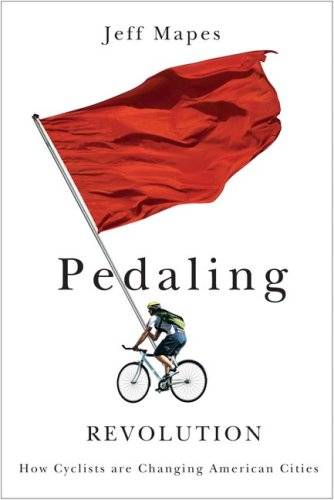Why does a person choose to ride their bike for useful transportation? And why are there some communities where cyclists are a routinely seen and an acknowledged part of the commuting scene, while other towns and cities are strictly the domain of automobiles? These are complex questions, but they often boil down to the resolve of activists and legislators to fight the ever-beckoning temptation of cheap, unsustainable sprawl and carve out a small niche in state and local budgets to fund (compared to highway expenditures) modestly-priced infrastructure improvements.
In his new book, Pedaling Revolution: How Cyclists are Changing American Cities (Oregon State Press, paper, $19.95), Portland, Ore. journalist Jeff Mapes takes a closer look at the factors inherent in personal transportation decisions, and profiles first European and then American cities that have had success in increasing the proportion of their citizens who ride bikes or walk to work.
The central theme of the book is that it’s incredibly difficult to fight against our car-centric culture, but meaningful progress can be made to get people out of their cars and onto their bikes. Sometimes it means building more bike lanes, connecting a trail system, or providing more bike parking (although there’s no clear consensus, even among cycling activists, about the best way to accommodate cyclists); sometimes it means marketing cycling as a “positive, sexy way forward — not a sacrifice,” as a transportation consultant put it; and sometimes it means preserving cyclists’ rights through legislation. Sometimes it just means being located somewhere where young, active people want to live and letting the momentum of your demographics take care of many of your problems for you. Mapes doesn’t provide a magic bullet, but he does delve into the guts of what’s going on in the places where things are working, and he comes away with some valuable insights.
He begins with a history of the major U.S. bike-advocacy organizations (the League of American Wheelmen — now the League of American Bicyclists, Rails to Trails Conservancy, and Bikes Belong) and traces an arc of America’s complicated relationship with practical bicycle use. Utilitarian cycling reached a peak in the 1970s with the Arab oil embargo, plummeted in the ’80s with cheap gas and bigger vehicles, and has slowly gained momentum in the last couple of decades, reaching its current point of “revolution,” which might be slightly hyperbolic depending on where you sit.
From there, he travels to the Netherlands (especially Amsterdam) and Denmark, where bicycles and cars move in magical harmony together, kids walk or ride to school, and average people say things like, “there are so many bikes, they don’t care about the cars.” That’s a long way from the reality of most American cities, and he tackles those next.
As might be expected, the communities profiled who are “doing things right” are located on the coasts and are stereotypical meccas for the young and hip. Portland, Davis, Calif., and New York City each get their own chapter, while inland cities like Boulder, Minneapolis, and Chicago get passing mentions.
Each featured community has specific attributes that contribute to its success in accommodating cycling. Portland’s bike scene has benefited from a one percent earmark for bike accommodations in their budget, as well as a law which limits sprawl and requires new developments to have greenways and connect to the existing trail system. The University of California campus at Davis was originally laid out by a bike lover who made it off-limits to cars, and it’s been fighting a losing battle against self-satisfaction (and Sacramento commuters) ever since. New York is too huge to be easily pigeonholed, but has benefited from the overwhelming car congestion which makes cycling a logical and practical alternative.
Later chapters focus on improving safety, getting kids to ride, and the fitness benefits of cycling, and the overriding theme remains clear. It’s easy and politically safe to advocate for better roads and lessening automobile congestion, while the average voter (and therefore the average politician) has no interest in financing public bike facilities. The more people who use bicycles as part of their daily lives, though, the less overwhelming that consensus is, and the more likely positive change will be possible. Or, you could just move to Portland or Amsterdam, and avoid all the intervening struggle. Your choice. I guess I’ll stay here in flyover country and do what I can to make things better.
———
I found out about this book through David Byrne‘s review in the New York Times. It’s way better than this one, and it’s definitely worth reading.
If you’re interested in local bike advocacy, check out ChampaignCountyBikes.org. They’re doing the Lord’s work.









